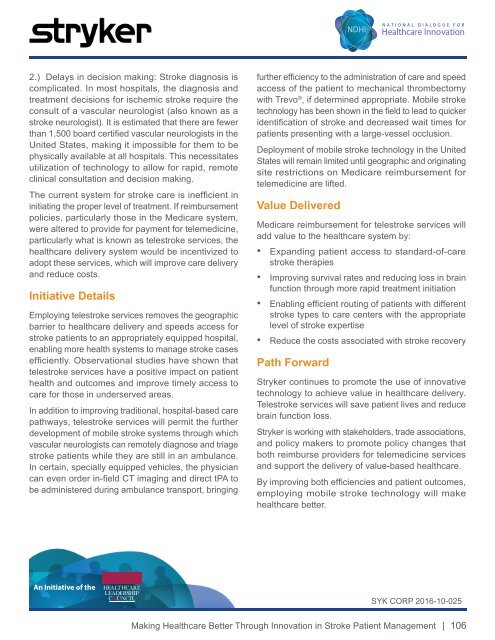VIable
HLCCompendium
HLCCompendium
Create successful ePaper yourself
Turn your PDF publications into a flip-book with our unique Google optimized e-Paper software.
NDHI<br />
NAT IONAL DIALOGUE FOR<br />
Healthcare Innovation<br />
2.) Delays in decision making: Stroke diagnosis is<br />
complicated. In most hospitals, the diagnosis and<br />
treatment decisions for ischemic stroke require the<br />
consult of a vascular neurologist (also known as a<br />
stroke neurologist). It is estimated that there are fewer<br />
than 1,500 board certified vascular neurologists in the<br />
United States, making it impossible for them to be<br />
physically available at all hospitals. This necessitates<br />
utilization of technology to allow for rapid, remote<br />
clinical consultation and decision making.<br />
The current system for stroke care is inefficient in<br />
initiating the proper level of treatment. If reimbursement<br />
policies, particularly those in the Medicare system,<br />
were altered to provide for payment for telemedicine,<br />
particularly what is known as telestroke services, the<br />
healthcare delivery system would be incentivized to<br />
adopt these services, which will improve care delivery<br />
and reduce costs.<br />
Initiative Details<br />
Employing telestroke services removes the geographic<br />
barrier to healthcare delivery and speeds access for<br />
stroke patients to an appropriately equipped hospital,<br />
enabling more health systems to manage stroke cases<br />
efficiently. Observational studies have shown that<br />
telestroke services have a positive impact on patient<br />
health and outcomes and improve timely access to<br />
care for those in underserved areas.<br />
In addition to improving traditional, hospital-based care<br />
pathways, telestroke services will permit the further<br />
development of mobile stroke systems through which<br />
vascular neurologists can remotely diagnose and triage<br />
stroke patients while they are still in an ambulance.<br />
In certain, specially equipped vehicles, the physician<br />
can even order in-field CT imaging and direct tPA to<br />
be administered during ambulance transport, bringing<br />
further efficiency to the administration of care and speed<br />
access of the patient to mechanical thrombectomy<br />
with Trevo ® , if determined appropriate. Mobile stroke<br />
technology has been shown in the field to lead to quicker<br />
identification of stroke and decreased wait times for<br />
patients presenting with a large-vessel occlusion.<br />
Deployment of mobile stroke technology in the United<br />
States will remain limited until geographic and originating<br />
site restrictions on Medicare reimbursement for<br />
telemedicine are lifted.<br />
Value Delivered<br />
Medicare reimbursement for telestroke services will<br />
add value to the healthcare system by:<br />
• Expanding patient access to standard-of-care<br />
stroke therapies<br />
• Improving survival rates and reducing loss in brain<br />
function through more rapid treatment initiation<br />
• Enabling efficient routing of patients with different<br />
stroke types to care centers with the appropriate<br />
level of stroke expertise<br />
• Reduce the costs associated with stroke recovery<br />
Path Forward<br />
Stryker continues to promote the use of innovative<br />
technology to achieve value in healthcare delivery.<br />
Telestroke services will save patient lives and reduce<br />
brain function loss.<br />
Stryker is working with stakeholders, trade associations,<br />
and policy makers to promote policy changes that<br />
both reimburse providers for telemedicine services<br />
and support the delivery of value-based healthcare.<br />
By improving both efficiencies and patient outcomes,<br />
employing mobile stroke technology will make<br />
healthcare better.<br />
SYK CORP 2016-10-025<br />
Making Healthcare Better Through Innovation in Stroke Patient Management<br />
| 106


